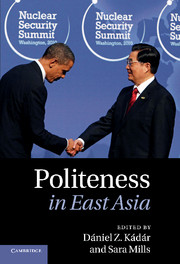Book contents
- Frontmatter
- Contents
- Notes on contributors
- Foreword
- Acknowledgements
- Abbreviations
- 1 Introduction
- Part I Politeness in East Asia: Theory
- 2 Politeness and culture
- 3 Honorifics: The cultural specificity of a universal mechanism in Japanese
- 4 Methodological issues in East Asian politeness research
- 5 Intercultural communication and East Asian politeness
- Part II Politeness in East Asia: Practice
- Notes
- Bibliography
- Index
5 - Intercultural communication and East Asian politeness
from Part I - Politeness in East Asia: Theory
Published online by Cambridge University Press: 07 September 2011
- Frontmatter
- Contents
- Notes on contributors
- Foreword
- Acknowledgements
- Abbreviations
- 1 Introduction
- Part I Politeness in East Asia: Theory
- 2 Politeness and culture
- 3 Honorifics: The cultural specificity of a universal mechanism in Japanese
- 4 Methodological issues in East Asian politeness research
- 5 Intercultural communication and East Asian politeness
- Part II Politeness in East Asia: Practice
- Notes
- Bibliography
- Index
Summary
Introduction
The analysis of politeness has often been approached from a cultural angle, describing the typical politeness norms of a specific culture (e.g. Pan, 2000a; Gu, 1990; Hickey and Stewart, 2005). While many of the enquiries into this subject have involved cross-cultural communication comparisons (e.g. Stadler, 2007; Blum-Kulka et al., 1989; Sifianou, 1992), not many have involved investigations into intercultural communication. This is to say, a great deal of the research on politeness has studied features of politeness in one culture and then compared them to features of politeness in another culture. Even publications in journals such as the Journal of Intercultural Communication Research often consist of cross-cultural comparisons that all too often rely on discourse completion tasks (DCT) or questionnaire data, rather than on authentic data from real-life intercultural encounters (e.g. Yu and Hsu, 2008; Pearson and Child, 2007; H. S. Park and Guan, 2006). Undoubtedly, there is value in such comparative studies, for example by exploring the perceptual effect differences in politeness norms have on members of different cultural backgrounds (Stadler, 2007). Nevertheless, such studies tell us little about what happens when members of two different cultures interact with one another (Miller, 2008). They give a valuable insight into politeness as it applies to the conversations, for example, of Chinese people conversing with other Chinese. However, one should not draw generalisations from intracultural behaviour to predict intercultural behaviour. In order to better understand politeness and its use in intercultural encounters, empirical studies on politeness in authentic intercultural interactions are required (see for example Spencer-Oatey, [2000] 2008).
The aim of this chapter is to examine critically a range of writings from different fields and their respective representations of politeness in an East Asian context. In order to be able to analyse some of the cultural stereotypes about politeness in different regions such as mainland China, Japan and Korea, in this chapter I examine writings geared towards a Western audience. Two different types of writings are discussed, popular writings and profession-specific writings. Popular writings consist mostly of a review of popular travel guides, writing on business and management and education writing. I analyse these genres in order to explore how well a person can prepare him- or herself for interactions with members of East Asian societies. The reason for a review of these popular writings lies in the fact that people frequently rely on the information such sources provide as preparation for overseas visits. The profession-specific writings reviewed in this chapter stem predominantly from linguistic politeness theory (defined in a somewhat loose sense) and the area of communication studies, rooted in psychology. Insights gained by professional writings will be scrutinised for the value they add to the knowledge gained from popular writings and for whether these writings manage to fill all the knowledge gaps necessary to enhance intercultural understanding.
- Type
- Chapter
- Information
- Politeness in East Asia , pp. 98 - 122Publisher: Cambridge University PressPrint publication year: 2011
- 7
- Cited by



